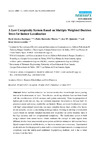Please use this identifier to cite or link to this item:
https://accedacris.ulpgc.es/jspui/handle/10553/15152
| DC Field | Value | Language |
|---|---|---|
| dc.contributor.author | Sánchez Rodríguez, David Cruz | - |
| dc.contributor.author | Hernández Morera, Pablo Vicente | - |
| dc.contributor.author | Quinteiro González, José María | - |
| dc.contributor.author | Alonso González, Itziar Goretti | - |
| dc.contributor.other | Sanchez, David | - |
| dc.date.accessioned | 2015-11-30T11:38:30Z | - |
| dc.date.accessioned | 2018-03-15T14:36:04Z | - |
| dc.date.available | 2015-11-30T11:38:30Z | - |
| dc.date.available | 2018-03-15T14:36:04Z | - |
| dc.date.issued | 2015 | - |
| dc.identifier.issn | 1424-8220 | - |
| dc.identifier.uri | https://accedacris.ulpgc.es/handle/10553/15152 | - |
| dc.description.abstract | Indoor position estimation has become an attractive research topic due to growing interest in location-aware services. Nevertheless, satisfying solutions have not been found with the considerations of both accuracy and system complexity. From the perspective of lightweight mobile devices, they are extremely important characteristics, because both the processor power and energy availability are limited. Hence, an indoor localization system with high computational complexity can cause complete battery drain within a few hours. In our research, we use a data mining technique named boosting to develop a localization system based on multiple weighted decision trees to predict the device location, since it has high accuracy and low computational complexity. The localization system is built using a dataset from sensor fusion, which combines the strength of radio signals from different wireless local area network access points and device orientation information from a digital compass built-in mobile device, so that extra sensors are unnecessary. Experimental results indicate that the proposed system leads to substantial improvements on computational complexity over the widely-used traditional fingerprinting methods, and it has a better accuracy than they have. | - |
| dc.language | eng | - |
| dc.relation.ispartof | Sensors (Switzerland) | - |
| dc.source | Sensors (Switzerland) [ISSN 1424-8220], v. 15 (6), p. 14809-14829 (Junio 2015) | - |
| dc.subject | 3325 Tecnología de las telecomunicaciones | - |
| dc.subject.other | WLAN indoor localization | - |
| dc.subject.other | Weighted decision trees | - |
| dc.subject.other | Received signal strength | - |
| dc.subject.other | Orientation | - |
| dc.subject.other | Sensor fusion | - |
| dc.title | A low complexity system based on multiple weighted decision trees for indoor localization | - |
| dc.type | info:eu-repo/semantics/Article | - |
| dc.type | Article | - |
| dc.identifier.doi | 10.3390/s150614809 | - |
| dc.identifier.scopus | 84933576054 | - |
| dc.identifier.isi | 000357869200135 | - |
| dcterms.isPartOf | Sensors | - |
| dcterms.source | Sensors [ISSN 1424-8220], v. 15 (6), p. 14809-14829 | - |
| dc.contributor.authorscopusid | 56690271600 | - |
| dc.contributor.authorscopusid | 36782546400 | - |
| dc.contributor.authorscopusid | 55548979800 | - |
| dc.contributor.authorscopusid | 56690273300 | - |
| dc.identifier.crisid | 3008;331;1722;1819 | - |
| dc.description.lastpage | 14829 | - |
| dc.identifier.issue | 6 | - |
| dc.description.firstpage | 14809 | - |
| dc.relation.volume | 15 | - |
| dc.investigacion | Ingeniería y Arquitectura | - |
| dc.rights.accessrights | info:eu-repo/semantics/openAccess | - |
| dc.type2 | Artículo | - |
| dc.identifier.wos | WOS:000357869200135 | - |
| dc.contributor.daisngid | 3316951 | - |
| dc.contributor.daisngid | 7323508 | - |
| dc.contributor.daisngid | 7207504 | - |
| dc.contributor.daisngid | 3636243 | - |
| dc.description.notas | This article belongs to the Special Issue Sensors for Indoor Mapping and Navigation | - |
| dc.identifier.investigatorRID | B-4519-2010 | - |
| dc.utils.revision | Sí | - |
| dc.contributor.wosstandard | WOS:Sanchez-Rodriguez, D | - |
| dc.contributor.wosstandard | WOS:Hernandez-Morera, P | - |
| dc.contributor.wosstandard | WOS:Quinteiro, JM | - |
| dc.contributor.wosstandard | WOS:Alonso-Gonzalez, I | - |
| dc.date.coverdate | Junio 2015 | - |
| dc.identifier.ulpgc | Sí | - |
| dc.description.sjr | 0,591 | |
| dc.description.jcr | 2,033 | |
| dc.description.sjrq | Q1 | |
| dc.description.jcrq | Q3 | |
| dc.description.scie | SCIE | |
| item.grantfulltext | open | - |
| item.fulltext | Con texto completo | - |
| crisitem.author.dept | GIR IDeTIC: División de Redes y Servicios Telemáticos | - |
| crisitem.author.dept | IU para el Desarrollo Tecnológico y la Innovación | - |
| crisitem.author.dept | Departamento de Ingeniería Telemática | - |
| crisitem.author.dept | GIR IUMA: Sistemas de Información y Comunicaciones | - |
| crisitem.author.dept | IU de Microelectrónica Aplicada | - |
| crisitem.author.dept | Departamento de Ingeniería Telemática | - |
| crisitem.author.dept | GIR IUMA: Sistemas de Información y Comunicaciones | - |
| crisitem.author.dept | IU de Microelectrónica Aplicada | - |
| crisitem.author.dept | Departamento de Ingeniería Telemática | - |
| crisitem.author.dept | GIR IDeTIC: División de Redes y Servicios Telemáticos | - |
| crisitem.author.dept | IU para el Desarrollo Tecnológico y la Innovación | - |
| crisitem.author.dept | Departamento de Ingeniería Telemática | - |
| crisitem.author.orcid | 0000-0003-2700-1591 | - |
| crisitem.author.orcid | 0000-0002-0907-4765 | - |
| crisitem.author.orcid | 0000-0002-6525-1316 | - |
| crisitem.author.orcid | 0000-0001-8487-2559 | - |
| crisitem.author.parentorg | IU para el Desarrollo Tecnológico y la Innovación | - |
| crisitem.author.parentorg | IU de Microelectrónica Aplicada | - |
| crisitem.author.parentorg | IU de Microelectrónica Aplicada | - |
| crisitem.author.parentorg | IU para el Desarrollo Tecnológico y la Innovación | - |
| crisitem.author.fullName | Sánchez Rodríguez, David De La Cruz | - |
| crisitem.author.fullName | Hernández Morera, Pablo Vicente | - |
| crisitem.author.fullName | Quinteiro González, José María | - |
| crisitem.author.fullName | Alonso González, Itziar Goretti | - |
| Appears in Collections: | Artículos | |
This item is licensed under a Creative Commons License

